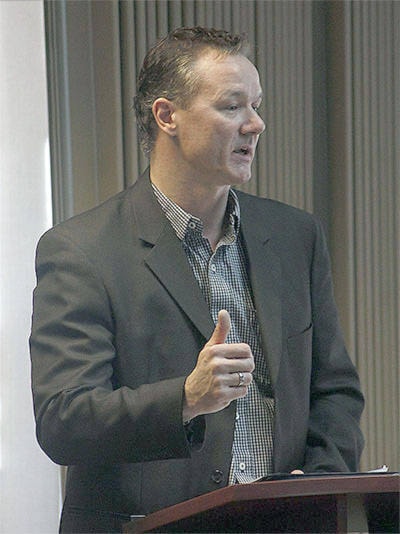Corey Sinclair, manager of regulatory affairs for FortisBC and a team of other staff members were in Castlegar last week for a public information session regarding the company’s proposed changes to their rate structure.
About 20 people showed up for the meeting. A similar meeting held a few days prior in Kelowna saw less than 10 people attend.
FortisBC has filed a cost of service analysis and rate design application to the B.C. Utilities Commission (BCUC).
The company is proposing phasing out over five years the current two-tier rate that sees an increase in the kilowatt-hour (kWh) charge once a customer uses more than 1600 kWh in a two month period.
When asked why Fortis BC would introduce the two-tiered rate and then take it away, Sinclair explained that FortisBC never asked for the two-tiered conservation rate, they were directed by the BCUC to institute it.
The changes in the rate structure will be revenue neutral for FortisBC, but will impact customers bills — some will pay more, some will pay less.
The application also reintroduces a time-of-use rate, offering customers an incentive to reduce bills by doing energy consuming tasks during off-peak hours.
Customers would have the option of signing up for the time-of-use rate or sticking to a flat rate.
“The only reason it would not only be on an optional basis is if for some reason the commission decides it would be mandatory … I don’t why they would do that, and I don’t think they would,” explained Sinclair.
Sinclair said the company had received complaints from customers with large homes or large families who felt the two-tiered rate structure treated them unfairly. One member of the audience pointed out that there are a large number of people in the area who use electric heat that are adversely affected by the tw0-tiered system.
“There are lots of reasons why people may have high consumption — it doesn’t mean they are being wasteful, it just means they have high consumption,” said Sinclair.
An analysis of current customers, assuming that no changes occurred in their usage, showed that under the proposed flat rate low consumers would see an increase in their bills and high consumers would see a slight decrease.
“A good rate is a rate that customers can understand and respond to,” explained Sinclair.
The company feels the time-of-use option will give customers options to reduce their bills.
The time-of-use discounts will vary by season as peak-use times change but the off-peak times remain the same for all seasons — 9 p.m. to 7 a.m. weekdays and all day weekends and holidays.
For winter (December through February) on-peak is considered from 7 a.m. to 12 p.m. and 4 p.m. to 9 p.m. weekdays. Mid-peak is 12 p.m. to 4 p.m. weekdays.
For the shoulder season (March to June and September to November) there is no on-peak time, mid-peak is 7 a.m. to 9 p.m. weekdays.
For summer (July and August) on-peak is 12 p.m. to 9 p.m. weekdays and mid-peak is 7 a.m. to 12 p.m. weekdays.
Proposed rates are on-peak 22.435¢/kWh, mid-peak 11.869¢/kWh and off-peak 9.280¢. Depending on the length of time approval takes, these rates may change.
Sinclair also explained that applications before the BCUC typically take more than a year, so it will still be a while before any changes take place.
